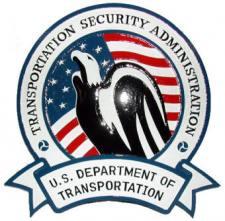Efficacy of TSA's behavioral threat detection program questioned
Between 2004 and 2008, more than two billion passengers boarded planes at the 161 U.S. airports in which TSA has deployed Behavioral Detection Officers (BDOs) under the Screening of Passengers by Observation Techniques (SPOT) program; the BDOs identified 152,000 passengers for secondary screening, which led to 1,083 arrests; none of those arrested, however, were terrorists or individuals who intended to attack the aviation system; GAO reports that since 2003, there were 16 instances in which airport screeners permitted people to get on planes who later were linked to terror plots

TSA emblem // Source: wordpress.com
At least seventeen suspected terrorists have evaded federal officers trained to spot suspicious behavior or signs of deception under an aviation security program the Government Accountability Office (GAO) describes as scientifically unreliable.
The GAO reports that the Transportation Security Administration (TSA) deployed the Screening of Passengers by Observation Techniques (SPOT) program program “without first validating the scientific basis for identifying suspicious passengers in an airport environment (.pdf).”
Rep. John Mica (R-Floridaq), the ranking member of the House Committee on Transportation and Infrastructure, seized on the report as one more instance of TSA ineffectiveness and waste. In a letter addressed to DHS secretary Janet Napolitano yesterday, Mica Mica urged the secretary (.pdf) “to initiate immediate efforts for the reevaluation and reorganization of the entire TSA, a bureaucracy that has ballooned in size and cost, and … is teetering on the verge of disaster.”
Mica also criticized the SPOT program’s effectiveness, noting seventeen suspected terrorists moved through eight SPOT airports on at least twenty-four different occasions. One of those suspected terrorists was the failed Times Square bomber Faisal Shahzad, who made it onboard an Emirates flight to Dubai at New York City’s JFK Airport earlier this month, despite being on the terrorist watch list and passing through a security checkpoint where the SPOT program operates. Federal authorities arrested Shahzad onboard the flight before it could take off.
Matthew Harwood writes that currently, there are about 3,000 behavioral detection officers (BDOs) (BDOs) deployed at 161 of 457 TSA-regulated airports, which cost taxpayers about $212 million this year, according to the GAO. The White House has asked for $232 million next year to expand the SPOT program. If Congress agrees and maintains this funding level, the program would cost approximately $1.2 billion over the next five years.
Under the SPOT program, TSA trains BDOs to walk the airport security line and observe passengers waiting to reach the security checkpoint. Usually working in teams of two, BDOs assess whether passengers are acting suspiciously and then score certain predetermined behaviors on a point system.
“For passengers exhibiting indicators above baseline conditions, the BDOs are to (mentally) add up the points assigned to each indicator they observe,” the GAO reports. “Both BDO team members must agree that observed indicators have exceeded the predetermined numerical threshold,” and if they do a passenger can be chosen to undergo secondary screening.
Harwood notes that on average, BDOs have thirty
